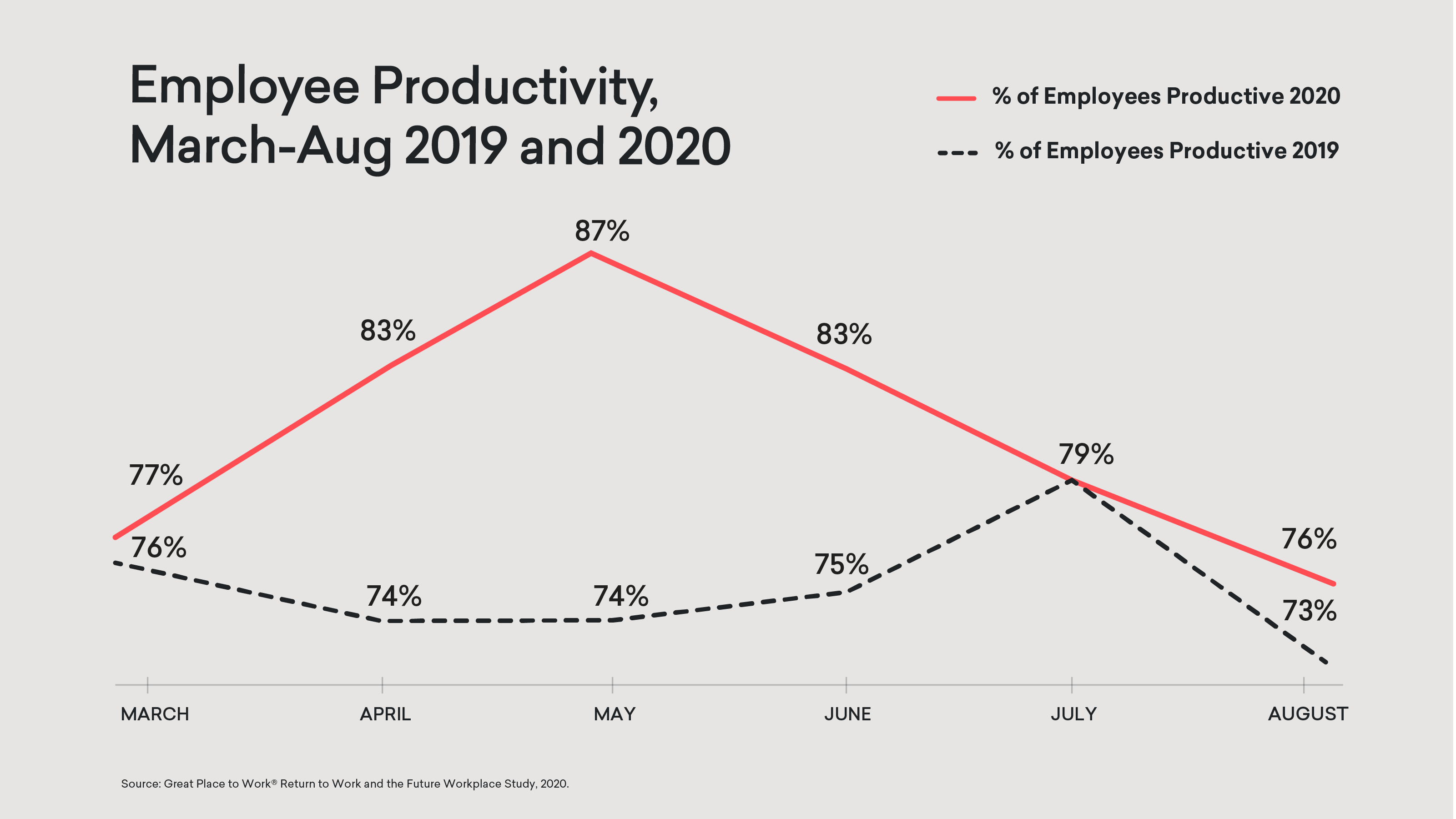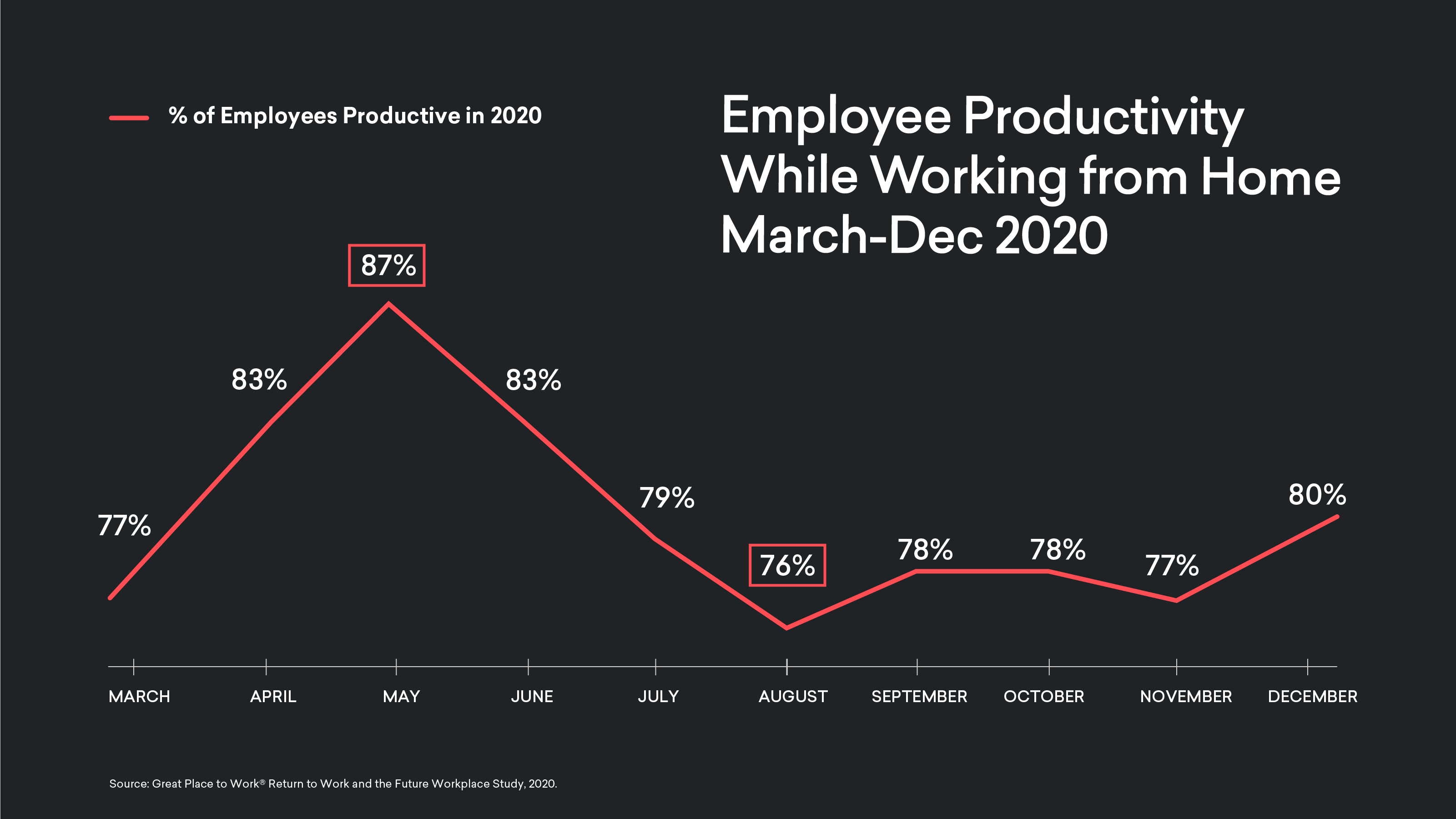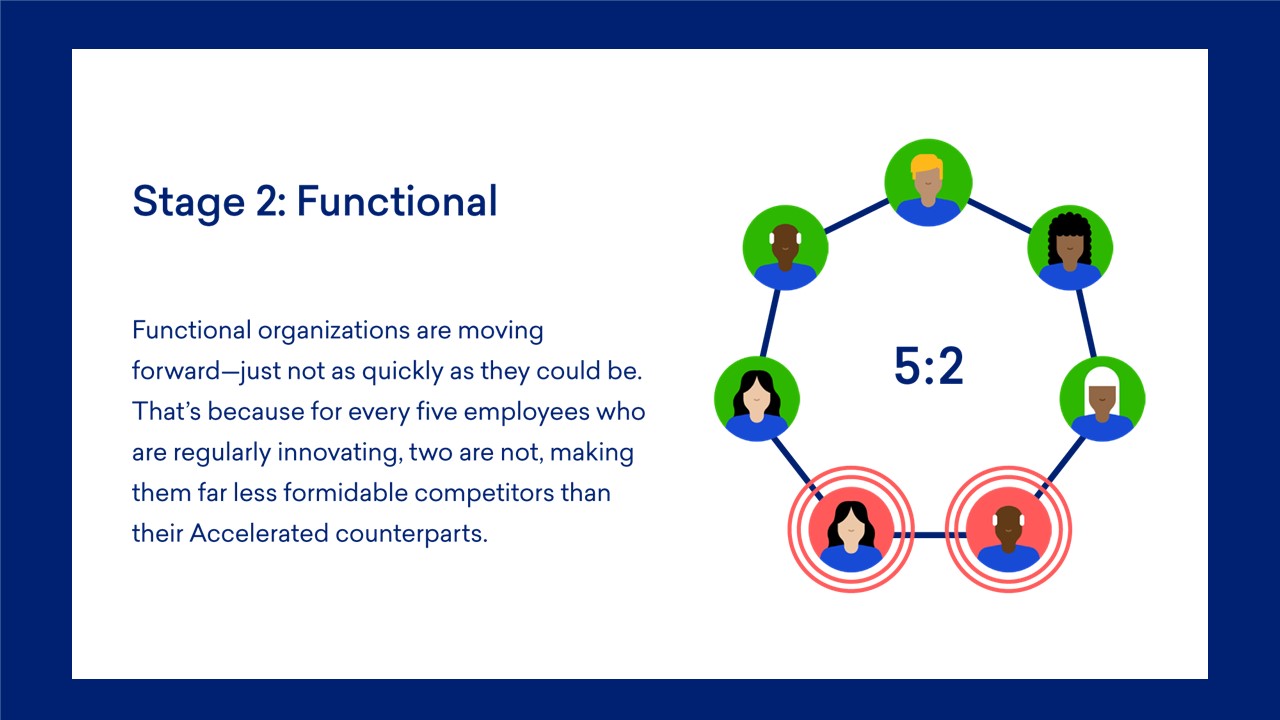Benchmarks & Trends, Employee Experience, Remote & Hybrid Culture, Research
Editor’s note: This article was originally published in 2020 and updated in 2025 to include new research and findings from 2024. The original study remains below for context and comparison.
Remote work isn’t new, but it is evolving. With millions still working outside traditional offices, questions about productivity, culture, and collaboration continue to shape the future of work. That’s why we revisited our original research with fresh 2024 data, analyzing responses from millions of employees across industries.
Spoiler: Remote work still works. But how it works best is shifting — it all comes down to culture, trust, and leadership.
In this updated post, we’ll walk you through our latest findings, compare them to our earlier research from 2019–2020, and share what leading companies are doing now to sustain performance and engagement.
2024–25 remote productivity study
As of February 2025, Gallup’s ongoing tracking of hybrid work arrangements in the U.S. found that 52% of U.S. employees whose jobs can be done remotely work in a hybrid environment.
Another 27% are fully remote. That’s 79% of employees spending at least some of their time working remotely — a significant enough percentage to shape how organizations operate.
In early 2024, the U.S. Bureau of Labor Statistics reported that 34 to 35.5 million people aged 25 and older worked from home for pay, up 5 million from the previous year. This underscored a continued shift toward remote work.
Team cooperation — not proximity — drives remote productivity
In 2024, a sweeping analysis of Trust Index™ Survey data covering 1.3 million employees at Great Place To Work® Certified™ firms revealed a fascinating truth: Cooperation stands out as the cornerstone of discretionary effort, a defining trait of outstanding productivity.
Employees who feel they can count on others to cooperate are 8.2 times more likely to give extra effort.
But do teams need to be co-located to cooperate? Not at all.
Of the companies on the 2025 Fortune 100 Best Companies to Work For®, 97 support remote or hybrid work. This study included 67,000 employees. And 84% of employees at these companies say they can count on colleagues to cooperate, compared to 65% in typical workplaces.
Employees at the Fortune 100 Best Companies don’t just show up — they show up strong. Productivity is nearly 42% higher at these companies compared to a typical U.S. workplace.
That extra drive shows up in all the right places: higher productivity, better customer service, stronger retention, and more agility when things shift.
Remote work paradox: When engagement rises but well-being falls
While our data shows strong and sustained productivity in remote environments, Gallup’s recent research adds nuance: High engagement doesn’t always mean high well-being.
Gallup’s latest “State of the Global Workplace” report found that fully remote workers report the highest engagement (31%) compared to hybrid (23%) and on-site workers (19%). But they also report lower well-being and higher instances of stress, anger, and loneliness.
The paradox?
Autonomy boosts productivity, but it can also increase cognitive load and emotional strain. Leaders should support social interaction, structure, and mental health alongside flexibility.
At high-trust workplaces, such as those found on the 100 Best Companies list, this paradox diminishes significantly due to exemplary leadership.
In our 2025 Fortune 100 Best survey, 81% of employees at these companies described their workplace as psychologically and emotionally healthy — a stark contrast to the 45% reported in typical U.S. workplaces.
This 45% higher rating underscores how strong leadership and intentional support create an environment where productivity and well-being thrive.
Does remote work increase productivity?
Historical data shows that working from home can be just as productive, if not more so, than traditional office setups. In 2022, Great Place To Work's two-year study of more than 800,000 employees found stable or improved productivity after transitioning to remote work.
In 2020, we surveyed 715 companies representing over 3 million U.S. employees. We measured productivity through responses to statements about effort and adaptability:
- People are willing to give extra to get the job done
- People quickly adapt to changes needed for their company’s success
Employee sentiment among productive remote workplaces
In the 2019–20 productivity study, we ran a comment analysis of employee survey responses to the open-ended question, “Is there anything unique or unusual about this company that makes it a great place to work?”
Interestingly, the most common phrase among people experiencing high productivity changed over time. In March to May of 2020, the most common phrase was “catered lunches at home,” indicating the power of perks for increasing employee well-being and productivity.
However, from June to August 2020, the most common phrase was “genuinely love.” Examples of these comments include:
- “We are genuinely loved here!”
- “I have never been so genuinely loved and cared for by a workplace. I truly feel connected to my co-workers, and they’re one of the best parts of my day.”
- “They are welcoming and open. Everyone that I talk to genuinely loves to be here every day, and that makes the hard stuff easier!”
From September to December of that year, “positive atmosphere” was the most used phrase by employees to describe what makes their company a great place to work.

While perks may have bolstered employee productivity during the early months of working from home, camaraderie and a positive culture influenced longer-term productivity.
“Camaraderie is like a secret weapon. When employees experience the nexus of great work, a powerful mission, and shared values, productivity soars,” explained Julian Lute, Great Place To Work strategic advisor.
“Employees in great workplaces believe their co-workers see them as whole people, with family, hobbies, and passions that they bring to work each day. When relationships are strong, employees feel energized and bring their skills to the table to collaborate on organizational goals.”
Strong leadership is key to maintaining productivity and employee well-being
Other unique phrases among employees who worked productively while remote were about leadership:
- “excellent leadership” and “outstanding leadership” from March to May
- “incredible leadership,” “culture leadership,” and “leadership understands” from June to August
- “incredible leadership” and “honest leadership” from September to December
Such comments reveal how much impact leadership can have on employee productivity. And amid the pandemic and all its uncertainty, the power of great leadership was on full display.
“When times are tough, leaders have the greatest opportunity to build trust. Their ability to navigate the complexities of the business, communicate effectively, and bring people along is more visible,” said Julian.
“Consistent communication and supporting people in shifting work arrangements, all while taking care of customers, is a balancing act. But leaders who are vulnerable help employees to experience the workplace as supportive and caring.”
Why poor leadership kills remote work productivity
Despite the initial increase, productivity fell in the summer of 2020, declining sharply from May to August by 11 percentage points (see graph).
However, by September, productivity began to pick up slightly, rising to 80% in December 2020 from its lowest point of 76% in August.

Employees who dipped in summer may have had a spring of “toxic productivity” — an unhealthy compulsion to work, perhaps out of fear of layoff or a loss of work–life balance amid lockdown. And toxic productivity almost always comes from the top.
Between June and August — the least productive months — the comment “Hire leaders” was repeated most by unproductive employees under survey questions about what could make the workplace better.
For example:
- “Hire leaders that are NOT top performers – they are not leaders, they are performers. There’s a difference. We need to start hiring leaders and people who can coach and motivate.”
- “We need to hire leaders that have experience. We should choose experience over friends any day, but that doesn’t always happen.”
- “Hire leaders throughout the company with more backbone who are willing to stand up for employees and pay people what their time is worth, not just the bare minimum.”
- “Train and hire leaders, not bosses.”
“Employees expect their leaders to lead, make decisions and support their work,” said Julian.
“Leaders who do not prioritize trust contribute to uncertainty, inconsistent communication, and lack of collaboration during challenging times. People expect their leaders to be guides and help them understand the broader business environment.”
Read more about the importance of trustworthy managers during a crisis.
Remote work productivity: then vs. now
In short: The early productivity drivers of remote work are now table stakes. Today, it’s your culture, leadership, trust and listening strategy that make the difference.
Best practices for boosting productivity in remote teams
1. Build a culture of trust and cooperation
Trust drives output. When employees feel safe, seen, and supported, they show up with more energy and initiative.
- Be transparent early and often. Leaders who openly share updates — especially the messy, in-progress ones — build credibility.
- Model cooperation. Try cross-functional “ask me anything” sessions. They boost alignment and make collaboration feel like the norm, not a hurdle.
Example: At Salesforce, the company holds regular “Ohana Meetings” where employees from different departments can ask questions and share updates. This practice has helped break down silos and foster a culture of transparency and cooperation.
2. Make communication easy, not exhausting
Clear beats constant. Remote teams don’t need more Zooms — they need better clarity and flow.
- Check in, not check up. Weekly one-on-ones or async video updates can do more for alignment than back-to-back meetings.
- Keep the human in remote. Dedicated Slack channels for random musings, pet pics, or weekend recaps go a long way in keeping team spirit alive.
3. Give them tools that actually help
The best tools are the ones people actually use.
- Choose wisely, not excessively. Pick collaboration platforms that suit your team’s workflow — and don’t overwhelm them with five apps that do the same thing.
- Make access easy. Set up a central hub or doc with logins, FAQs, and SOPs so no one’s hunting for info.
Example: At DHL Express, the “Smart Connect” intranet serves as a comprehensive hub, uniting 116,000 employees worldwide through streamlined access to local news, company policies, strategic updates, and HR tools.
Designed to bridge operational and office divisions, the platform delivers content in local languages and offers personalized self-services, including payroll, attendance systems, job portals, and learning platforms.
Beyond its practical functions, Smart Connect fosters a sense of community with social walls enabling employees — from the CEO in Florida to couriers in Malaysia — to share stories, photos, and videos, embodying the company’s #AsOne ethos.
4. Flexibility isn’t a perk — It’s a productivity multiplier
Let people work how they work best.
Evidence from our report, “Return-to-Office Mandates and the Future of Work,” underscores a critical truth: mandating where employees work dampens productivity, whether onsite or remote. Conversely, when individuals or teams tailor policies to their needs, the result is striking — more employees are willing to go the extra mile.
The statistics are telling. Fewer workers subject to rigid mandates report exerting discretionary effort, regardless of location. Flexibility, it appears, nurtures not only autonomy but also commitment. By granting employees the freedom to choose how and where they work best, organizations unlock a potential that rigid policies often stifle.
- Offer flexible hours: A 9-to-5 mindset doesn’t always make sense across time zones or energy peaks.
- Give autonomy: The more ownership you hand over, the more initiative you’ll see in return.
Example: Australian-American proprietary software company Atlassian also supports flexibility through its “Team Anywhere” policy. It lets employees choose where to work each day, leading to a significant increase in applications and retention.
5. Prioritize well-being like it’s a business metric
Because it is. Burnout doesn’t show up on spreadsheets — until it does.
- Normalize real breaks. Encourage calendar blocking for deep work and protect “off” time like you would a client meeting.
- Support beyond work. Mental health stipends or open-access wellness resources show you actually mean it.
Example: Intuit’s approach to hybrid work harmonizes the rhythms of in-office and remote productivity, enriching its physical spaces with the essence of local art and cuisine. The well-being of employees is not merely acknowledged but celebrated through an expansive benefits package.
This includes home office reimbursements, access to mental health counseling, on-site fitness facilities, and a “Well-Being for Life” reimbursement valued at $1,300. Intuit also fosters a culture of vitality by championing healthy habits, rewarding them through the Virgin Pulse wellness program.
6. Celebrate progress — big or small
Recognition fuels momentum.
- Make shoutouts a habit. Try “wins of the week” in team chats or highlight reels in all-hands meetings.
- Create feedback loops. Let employees know what’s working — and how they’re contributing to the bigger picture.
Example: Ally Financial Inc. goes all in on recognition through initiatives like “BRIEFally” and “LEADing the Way,” spotlighting teammates who live the company’s values. Whether in-person or virtual, Ally ensures employees are celebrated through weekly shoutouts in newsletters and annual leadership awards.
This approach highlights not just what they achieve but how they do it. Recognitions like these boost morale while reinforcing the company’s “Do it Right” mission — empowering employees to carry their impact forward.
7. Keep growing — together
Innovation doesn’t just happen — it’s invited.
- Encourage curiosity. Host optional “skill swaps” or book club sessions where teammates can share what they’re learning.
- Make learning part of the plan. Budget time and resources for development — not just deadlines.
Remote productivity isn’t about squeezing more out of people — it’s about creating the conditions where people want to do their best work. The more you invest in clarity, trust, and well-being, the more sustainable your team’s success becomes.
Want to future-proof productivity in your remote or hybrid workplace?
Start by listening. Our Trust Index Survey and pulse tools help you uncover what really drives performance — so you can act on what matters most.
Turn culture insights into business wins
Let the Trust Index™ Survey reveal your workplace’s hidden strengths and areas for growth. Start transforming today.












